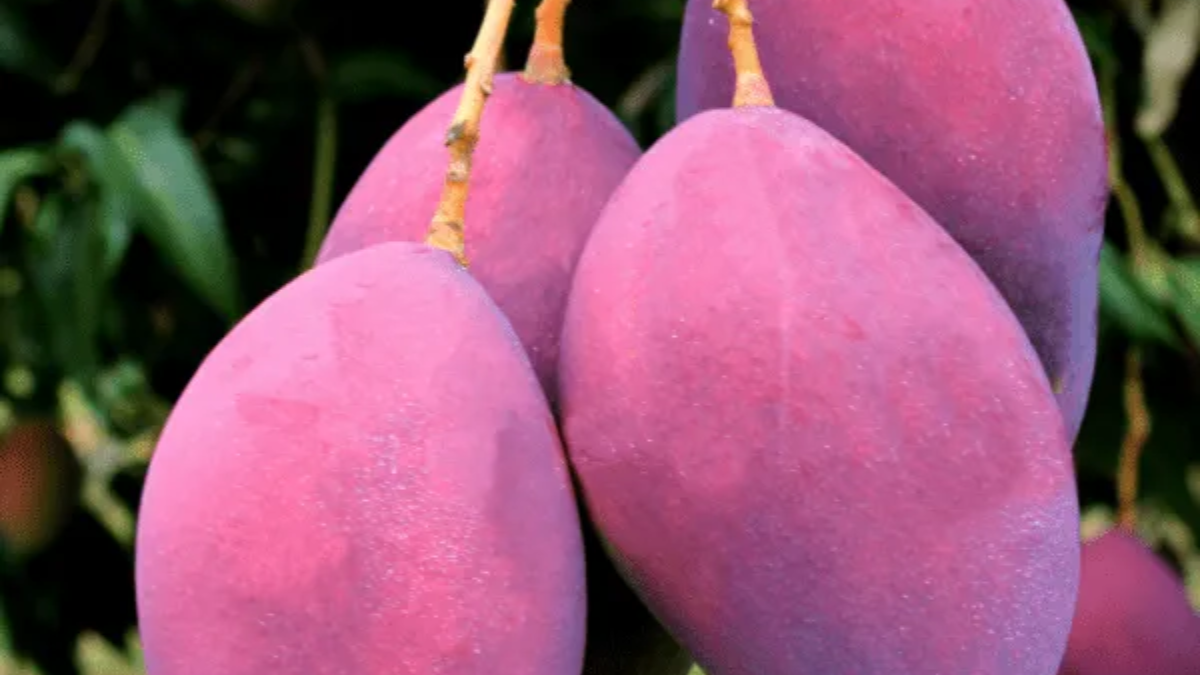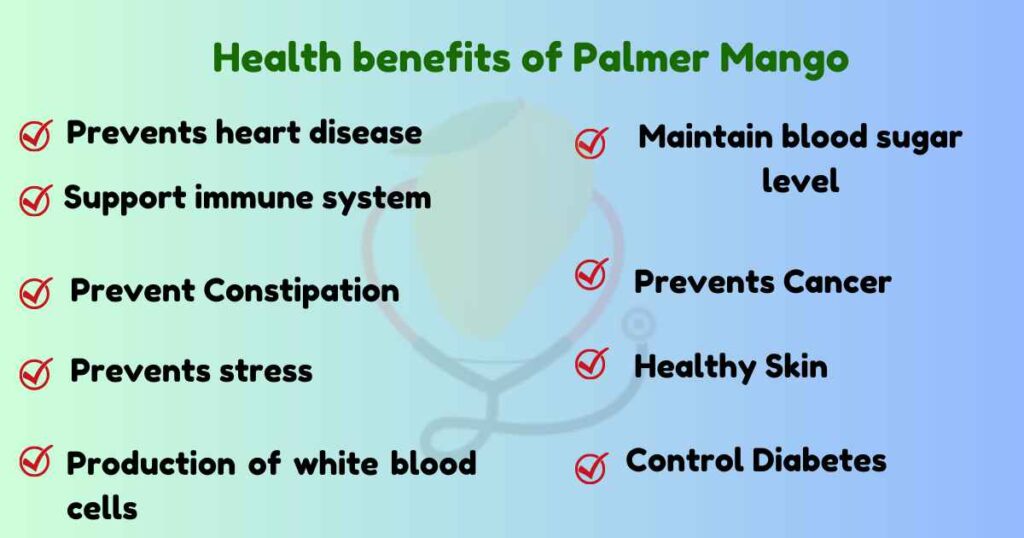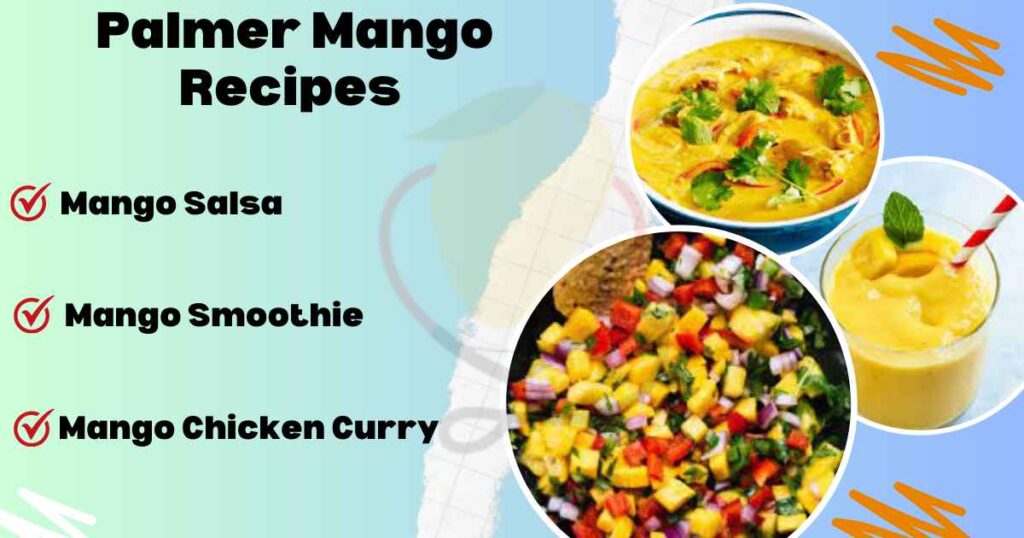Palmer Mango is a large, late-season variety grown in south Florida. It has sweet, fibrous-free, yellow flesh with low acidity, making it perfect for smoothies and exotic desserts.
Despite its dark color, it tastes remarkably better than other late February varieties like Keitt. [1]

In this article, we will explore the Palmer mango, its history, cultivation, nutritional benefits, and some delicious recipes to try at home.
Origin of Palmer Mango
The Palmer mango is a cultivar of the Mangifera Indica species that was developed in South Florida in the late 20th century.
It was named after the grower, Dr. A. J. Palmer, who created it by crossbreeding the Tommy Atkins and Kent mango varieties. [2]
The Palmer mango was first introduced to the market in the early 1990s and has since become a popular variety among mango lovers.
Characteristics of palmer mango
Palmer mangoes are a variety of mango that is known for their large size, sweet flavor, and bright orange flesh.
Here are some of the key characteristics of Palmer mangoes:
1: Appearance
- Palmer mangoes are large, oval-shaped fruit with a greenish-yellow skin that often has a red or orange blush.
- The flesh is bright orange and juicy, with a sweet, tropical flavor.
2: Size
- Palmer mangoes are one of the largest varieties of mango, with an average weight of 2-3 pounds per fruit.
- They can grow up to 6 inches in length and 4 inches in width.
3: Ripening
- Palmer mangoes ripen from June to August and are ready to eat when the skin turns from green to yellow and the flesh becomes soft to the touch.
- They are often harvested when they are still firm and allowed to ripen off the tree.
4: Flavor
- Palmer mangoes are known for their sweet, tropical flavor, which is often described as a mix of pineapple, peach, and citrus.
- The flesh is juicy and soft, with a melting texture that is similar to butter.
Cultivation of Palmer Mango
Palmer mango tree is a large, evergreen tree that can grow up to 100 feet tall. It requires a tropical or subtropical climate with plenty of sunshine and rainfall.
The tree produces fruit from June to August, and the ripe fruit has a bright orange-red color and a sweet, juicy flesh.
The Palmer mango is grown in many countries, including the United States, Mexico, and South America.
In the United States, the majority of Palmer mangoes are grown in Florida, where the warm climate and rich soil provide optimal growing conditions.
Nutrition of Palmer Mango
Palmer mango, in particular, is a good source of vitamin C, vitamin A, and dietary fiber. One cup of sliced mango contains approximately: [3]

Health benefits of Palmer Mango
Palmer mangoes are not only delicious but also packed with nutrients that offer a range of health benefits.

Here are some of the top health benefits of Palmer mangoes: [4]
1: Rich in Antioxidants
Palmer mangoes are an excellent source of antioxidants, which help protect the body against damage from harmful molecules called free radicals. [5]
Antioxidants are important for maintaining good health and reducing the risk of chronic diseases such as cancer and heart disease.
2: High in Fiber
Palmer mangoes are also a good source of dietary fiber, which is important for maintaining a healthy digestive system. [6]
Fiber helps to regulate bowel movements and prevent constipation, and it also helps to lower cholesterol levels and reduce the risk of heart disease.
3: Good for the Immune System
Palmer mangoes are rich in vitamin C, which is essential for maintaining a healthy immune system. [7]
Vitamin C helps to boost the production of white blood cells, which are responsible for fighting off infections and diseases.
4: May Help Prevent Cancer
Some studies have suggested that the compounds in mangoes, including antioxidants and polyphenols, may help prevent the growth and spread of cancer cells. [8]
5: May Help Regulate Blood Sugar
Palmer mangoes have a low glycemic index, which means that they are unlikely to cause a rapid spike in blood sugar levels.
This makes them a good choice for people with diabetes or those who are trying to manage their blood sugar levels. [9]
6: Promotes Healthy Skin
Palmer mangoes are rich in vitamin A, which is important for maintaining healthy skin. Vitamin A helps to promote cell growth and repair, and it also helps to protect the skin against damage from UV rays and environmental toxins. [10]
Delicious Palmer Mango Recipes
Here are a few delicious recipes to try using Palmer mangoes.

Palmer mango is a delicious and nutritious tropical fruit that is enjoyed by people all around the world. With its sweet, juicy flesh and high vitamin and fiber content, it is a great addition to any diet. Whether you eat it fresh, in a smoothie, or in a savory dish like curry, the Palmer mango is sure to please.
FAQs
Are Palmer mangoes good?
Palmer mangoes are a most unusual dark colored mango but surprisingly good to eat.
What is the difference between the Palmer mango and other mango varieties?
The Palmer mango has a unique flavor that is sweeter and less tart than some other varieties. It is also known for its bright orange-red color and juicy flesh.
Can you eat the skin of a Palmer mango?
No, the skin of a mango is not edible and should be peeled before eating.
Is the Palmer mango available year-round?
No, the Palmer mango is a seasonal fruit that is typically available from June to August.
Are there any health benefits to eating mangoes?
Yes, mangoes are a good source of vitamin C, vitamin A, and dietary fiber. They also contain antioxidants and other beneficial compounds that may help prevent chronic diseases.

